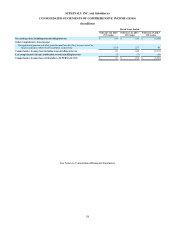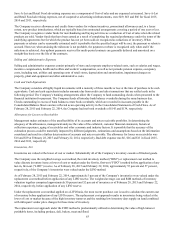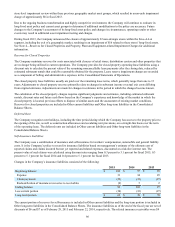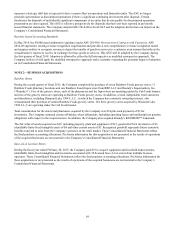Albertsons 2015 Annual Report Download - page 66
Download and view the complete annual report
Please find page 66 of the 2015 Albertsons annual report below. You can navigate through the pages in the report by either clicking on the pages listed below, or by using the keyword search tool below to find specific information within the annual report.64
As of February 28, 2015 and February 22, 2014, approximately 26 percent and 25 percent, respectively, of the Company’s
inventories were valued using the cost, weighted average cost and RIM methods under the FIFO method of inventory
accounting. The remaining 19 percent and 18 percent of the Company’s inventories as of February 28, 2015 and February 22,
2014, respectively, were valued using the replacement cost approach under the FIFO method of inventory accounting. The
replacement cost approach applied under the FIFO method results in inventories recorded at the lower of cost or market
because of the very high inventory turnover and the resulting low inventory days supply for these items of inventory.
During fiscal 2014 and 2013, inventory quantities in certain LIFO layers were reduced. These reductions resulted in a
liquidation of LIFO inventory quantities carried at lower costs prevailing in prior years as compared with the cost of fiscal 2014
and 2013 purchases. As a result, Cost of sales decreased by $14 and $6 in fiscal 2014 and 2013, respectively. If the FIFO
method had been used to determine cost of inventories for which the LIFO method is used, the Company’s inventories would
have been higher by approximately $211 and $202 as of February 28, 2015 and February 22, 2014, respectively.
The Company evaluates inventory shortages throughout each fiscal year based on actual physical counts in its facilities.
Allowances for inventory shortages are recorded based on the results of these counts to provide for estimated shortages as of
the end of each fiscal year.
Property, Plant and Equipment, Net
Property, plant and equipment are carried at cost. Depreciation is based on the estimated useful lives of the assets using the
straight-line method. Estimated useful lives generally are ten to 40 years for buildings and major improvements, three to ten
years for equipment, and the shorter of the term of the lease or expected life for leasehold improvements and capitalized lease
assets. Interest on property under construction of $1, $1 and $4 was capitalized in fiscal 2015, 2014 and 2013, respectively.
Business Dispositions
The Company reviews the presentation of planned business dispositions in the Consolidated Financial Statements based on the
available information and events that have occurred.
The review consists of evaluating whether the business meets the definition as a component for which the operations and cash
flows are clearly distinguishable from the other components of the business, and if so, whether it is anticipated that after the
disposal the cash flows of the component would be eliminated from continuing operations and whether the Company will have
any significant continuing involvement with the business. In addition, the Company evaluates whether the business has met the
criteria to be classified as a business held for sale. In order for a planned disposition to be classified as a business held for sale,
the established criteria must be met as of the reporting date, including an active program to market the business and the
expected disposition of the business within one year.
Planned business dispositions are presented as discontinued operations when all the criteria described above are met.
Operations of the business components meeting the discontinued operations requirements are presented within Income (loss)
from discontinued operations, net of tax in the Consolidated Statements of Operations, and assets and liabilities of the business
component planned to be disposed of are presented as separate lines within the Consolidated Balance Sheets. See Note 16—
Discontinued Operations for additional information.
Businesses held for sale are reviewed for recoverability of the carrying value of the business upon meeting the classification
requirements. Evaluating the recoverability of the assets of a business classified as held for sale follows a defined order in
which property and intangible assets subject to amortization are considered only after the recoverability of goodwill, indefinite
lived intangible assets and other assets are assessed. After the valuation process is completed, the held for sale business is
reported at the lower of its carrying value or fair value less cost to sell, and no additional depreciation or amortization expense
is recognized. The carrying value of a held for sale business includes the portion of the accumulated other comprehensive loss
associated with pension and postretirement benefit obligations of the operations of the business.
There are inherent judgments and estimates used in determining impairment charges. The sale of a business can result in the
recognition of a gain or loss that differs from that anticipated prior to closing.
Goodwill
The Company reviews goodwill for impairment during the fourth quarter of each year, and also if events occur or
circumstances change that would more-likely-than-not reduce the fair value of a reporting unit below its carrying amount. The
reviews consist of comparing estimated fair value to the carrying value at the reporting unit level. The Company’s reporting
units are the operating segments of the business which consist of Independent Business, Save-A-Lot and Retail Food. Fair
values are determined by using both the market approach, applying a multiple of earnings and revenue based on guidelines for
publicly traded companies, and the income approach, discounting projected future cash flows based on management’s
























